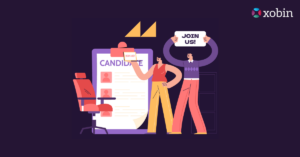Campus hiring is changing faster than ever. With AI-native students, hybrid recruitment events, and stiff talent competition, companies can no longer rely on outdated campus hiring playbooks. Traditional methods often lead to slow screening, inconsistent evaluation, and high campus-to-hire drop-offs. To stay competitive in 2025, organizations must modernize their campus recruitment process with data, automation, and structured hiring strategies.
Table of Contents
In this blog, we break down the actionable steps leaders can take to build a faster, fairer, and more scalable campus recruitment engine.
TL;DR – Key Takeaways!
- Skill-based hiring and AI-driven shortlisting significantly improve quality-of-hire while cutting hiring time.
- Digital assessments, proctoring, and video interviews help scale campus recruitment across multiple geographies.
- Employer branding, candidate engagement, and communication reduce drop-offs during campus drive.
Analytics and automation streamline evaluation and onboarding for smarter, faster decisions. - Campus recruitment software like Xobin help organizations run large-scale, structured, and unbiased campus hiring end-to-end.
Why the Campus Recruitment Process Needs an Upgrade in 2025
Campus hiring gives companies one of the fastest ways to build a strong early-talent pipeline and provides access to high-potential graduates who want to contribute. However, the landscape has changed. Hybrid placements, tech-savvy graduates, and skill-based roles now require much more structure and speed than older processes delivered.
Today the process needs more agility and digital readiness than before. Recruiters now handle high application volumes, limited screening time, and growing expectations from students used to digital experiences.
Traditional processes often fall short because:
- Manual screening slows down shortlisting. Reviewing hundreds of resumes for fresher roles leads to bottlenecks.
- Unstructured evaluation leads to hiring inconsistencies. Different interviewers may evaluate differently, creating bias.
- Offer drop-offs are rising. Students receive multiple offers and favor employers who communicate promptly.
- Campus-to-corporate transition is fragmented. Poor onboarding reduces engagement and early retention.
In 2025, efficiency means adopting data-driven, digital-first hiring methods while ensuring fairness, transparency, and a strong employer brand. Organizations that modernize their approach will not only hire faster but also win the best early talent consistently.

8 Steps to Make Your Campus Recruitment Process Efficient
Step 1: Build a Skills-First Hiring Framework
i. Start with role clarity and competencies
A skills-first framework ensures that campus hiring decisions are based on ability, not academic pedigree or resume quality. Fresh graduates often lack comprehensive resumes, making skill-based evaluation essential.
A structured hiring framework should outline:
- Technical skills like coding, analytics, domain expertise, and tool proficiency.
- Cognitive abilities such as logical reasoning, problem-solving, and numerical strength.
- Behavioral traits include teamwork, adaptability, time management, and accountability.
- Cultural alignment covering values fit, communication style, and long-term potential.
When you clearly outline these competencies upfront, you create a consistent evaluation system across campuses. This approach also reduces bias and ensures that students from lesser-known institutions receive fair opportunities.
ii. Shift from CV-based shortlisting to skill-based screening
Reliance on resumes is no longer sustainable; freshers often lack structured CVs. Instead, use:
- Aptitude assessments
- Domain or coding tests
- Communication evaluations
- Psychometric or behavioral assessment tests
These assessments provide an objective baseline that reduces bias and improves hiring predictability.
Additionally, a skills-first model helps companies tap into talent from Tier 2 and Tier 3 colleges without compromising on quality.

Step 2: Use AI Tools to Accelerate Screening and Shortlisting
AI is now indispensable for managing large-scale campus hiring efficiently. Instead of manually reviewing resumes, companies can rely on AI-driven shortlisting tools that scan, categorize, and score candidate profiles.
Key advantages of AI in campus hiring include:
- Resume parsing to extract skills, certifications, academics, and keywords instantly.
- Fitment scoring that matches candidates to the job description based on required competencies.
- Automated anomaly detection for identifying inconsistencies or discrepancies.
- Objective shortlisting that removes bias and improves accuracy.
AI dramatically reduces recruiter workload and ensures faster turnaround during peak hiring cycles. Companies that embrace AI candidate screening can shortlist thousands of candidates in hours rather than days.
Step 3: Implement Standardized Online Assessments for Fair Evaluation
Online assessments form the foundation of an efficient campus recruitment process. Since fresh graduates lack industry experience, assessments help employers evaluate their potential more accurately.
Modern assessment stacks for campus hiring may include:
- Aptitude tests for analytical, logical, and quantitative reasoning.
- Coding assessments for technical and product roles.
- Domain-specific skill tests for finance, HR, marketing, engineering, or operations roles.
- Communication tests for evaluating verbal and written clarity.
- Psychometric assessments that measure behavioral traits and workplace compatibility.
- Situational judgment tests (SJTs) that reveal decision-making patterns.
Standardization is crucial because it eliminates subjective judgment and ensures every applicant undergoes the same evaluation. This brings transparency, fairness, and reliability to the campus recruitment process.
To maintain exam integrity, companies should incorporate advanced proctoring methods:
- Face detection and gaze monitoring
- Tab-switch alerts and browser restrictions
- Unauthorized device detection
- Voice and background monitoring
Such layered proctoring ensures credibility even during remote campus assessments.

Step 4: Use One-Way and Live Video Interviews for Faster Evaluation
Video interviewing is now a central component of modern campus recruitment. It eliminates scheduling delays and enables organizations to assess thousands of students quickly.
One-way video interviews allow candidates to record answers anytime, while recruiters review responses asynchronously. This creates enormous scheduling flexibility and reduces panel fatigue.
Live video interviews help recruiters conduct final evaluation and culture-fit rounds. They offer deeper insight into communication style, personality, and problem-solving methods.
Benefits of using video interviews include:
- Faster screening of large applicant pools
- Consistent questioning using structured templates
- Ability to evaluate communication and articulation
- Reduced logistical costs and time
AI-assisted insights, such as tone analysis, keyword detection, clarity scoring, and behavioral mapping, help interviewers make fair, data-backed decisions.
Step 5: Strengthen Employer Branding to Attract the Best Students
In 2025, campus hiring is as much about marketing as it is about recruitment. Students are highly informed and selective; they prioritize companies that offer growth, learning opportunities, and a positive culture.
Strong employer branding requires:
- Engaging pre-placement talks (PPTs) that highlight values, culture, and career paths.
- Campus ambassador programs to extend employer influence throughout the year.
- Sharing real employee stories on LinkedIn, Instagram, and YouTube.
- Highlighting internships, rotational programs, and mentorship opportunities.
- Clear communication of impact, innovation, and career progression paths.
A powerful employer brand not only attracts more applicants but also improves offer acceptance and reduces drop-offs.
Step 6: Streamline Offer Management to Reduce Drop-Offs
One of the biggest hurdles in campus hiring is the widening gap between offer acceptance and joining. Students often hold multiple offers and tend to choose companies that communicate clearly, act quickly, and provide transparency.
To reduce drop-offs:
- Send offer letters quickly using automated workflows.
- Use digital verification and e-signatures to shorten documentation steps.
- Maintain communication through reminders, updates, and engagement content.
- Offer insights into training programs, team structure, and job responsibilities.
Organizations that keep students engaged between offer and joining typically see higher joining ratios and better employee readiness.
Step 7: Digitize Onboarding for a Smooth Campus-to-Corporate Transition
Onboarding sets the tone for an employee’s long-term engagement. For fresh graduates entering the corporate world, structured onboarding is especially critical.
A digital onboarding system helps:
- Simplify document collection, verification, and compliance.
- Provide candidates with structured training paths.
- Introduce them to organizational values, systems, and team members.
- Build familiarity using welcome videos, culture decks, and buddy programs.
- Ensure seamless joining even in hybrid or remote setups.
Strong onboarding boosts retention, accelerates productivity, and helps students transition into professional roles confidently.
Step 8: Use Analytics to Continuously Improve Campus Hiring Strategy
Data is one of the most powerful tools for decision-making in campus recruitment. Instead of relying on intuition, HR teams can use analytics to understand what works and where improvements are needed.
Key metrics to track include
- Campus-wide performance trends
- Assessment-to-interview conversion rates
- Interview-to-offer ratios
- Offer acceptance and decline reasons
- Joining ratios and retention of campus hires
- Diversity distribution
- Post-hire performance
With data insights, talent leaders can identify the most effective institutions, improve recruiter performance, and optimize hiring timelines.

Streamline the Entire Campus Hiring Process with Xobin
Xobin offers an AI-powered talent assessment and recruitment automation platform designed to make campus hiring seamless, scalable, and bias-free.
Here’s how Xobin transforms campus recruitment:
- 3,400+ skills-based assessments across domains like coding, aptitude, finance, marketing, HR, and engineering.
- AI Resume Parsing & Fitment Score to instantly shortlist candidates matched to role requirements.
- One-way and live video interviews with AI-driven evaluation for communication and behavioral analysis.
- Advanced proctoring using EyeGazer, tab-switch detection, unauthorized device detection, and more.
- Automation workflows for scheduling, reminders, candidate engagement, and communication.
- Analytics dashboards offering insights into candidate performance, campus effectiveness, and hiring quality.
Whether your organization is hiring 50 graduates or 5,000, Xobin provides the infrastructure, intelligence, and reliability required to run large-scale campus hiring efficiently.
If you’re ready to elevate your campus hiring strategy, book a personalized demo with Xobin today and experience how AI-powered recruitment can reshape your campus drives.
FAQs
1. What is the most effective way to shortlist candidates during campus hiring?
Using AI screening combined with skills-based assessments offers the fastest and most objective method of shortlisting candidates.
2. Why are online assessments important for campus recruitment?
They provide a standardized, fair, and scalable mechanism to evaluate students across locations and institutions.
3. How can video interviews help in campus hiring?
They reduce scheduling delays, lower logistical costs, and enable faster, unbiased evaluations.
4. What should companies do to reduce student offer drop-offs?
Speed, communication, engagement, and clarity, these four elements significantly increase joining ratios.
5. How does employer branding impact campus hiring success?
A strong employer brand attracts high-potential candidates and improves offer acceptance by building trust and credibility.






